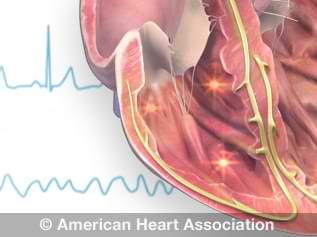Cardiac Event Recorder
A cardiac event recorder is a portable device that you wear or carry to record your heart’s electrical activity (ECG) as you go about your normal activities. There are multiple types of event recorders: implanted and external loop memory monitors, symptom event monitors and patch recorders.
Cardiac event recorders are also called ambulatory ECG monitors.
These monitors can note changes in how fast your heart is beating and changes in its rhythm to help health care professionals diagnose an arrhythmia, or irregular heartbeat, and check whether treatments for the abnormal heart rhythm are working.
Why do people use a cardiac event recorder?
Tests such as electrocardiograms let your health care professional look at your heart’s activity at rest and at one point in time. But abnormal heart rhythms and cardiac symptoms may come and go. The main purpose of an event monitor is to record your heart rate and rhythm during a symptom (“event”). Your health care professional may recommend an event monitor when symptoms are less than daily.
You may be asked to wear a cardiac event recorder if you have fast, slow or irregular heartbeats.
Watch an animation of an arrhythmia.
Wearing the monitor may tell your health care professional:
- If your medications are working.
- If a pacemaker or an implantable cardioverter defibrillator (ICD) is working properly.
- Why you have symptoms such as chest pain, dizziness, faintness or the feeling that your heart is racing or skipping a beat.
- If your heart is getting enough oxygen to meet its needs.
What are the risks of cardiac event recorders?
Wearing a cardiac event recorder has no risks and causes no pain. However, if you wear electrode patches, the adhesive might irritate your skin. Any skin irritation disappears when the patches are removed.
What are the types of event recorders?
- A looping memory monitor is a small device about the size of a pager that can be programmed to record your ECG for a period of time, such as five minutes. You must push a button to activate it, and it stores your ECG for the period before and during your symptoms. If you faint or have other symptoms and push the button after you recover, it will record your ECG during the time you felt faint and passed out, and right after you pushed it.
- A symptom event monitor can be either a hand-held device or worn on your wrist. When you feel a symptom or irregular heartbeat, you place the monitor on your chest and activate a recording button. The back of this device has small metal discs that function as the electrodes. If the monitor is worn on a wrist, you press the button to record. This stores your ECG in memory. Unlike the looping memory monitor, these won’t store your ECG before you activate it.
- A patch recorder doesn’t use wires or electrodes. It continuously monitors ECG activity for 14 days using an adhesive patch that sticks to the chest.
- An implantable loop recorder is implanted under the skin on the chest and can be left in place for three or more years. These devices can send your ECG by telephone to a transmission or receiving center in the hospital, medical office or monitoring company. A staff person receives your ECG “tracing” and gives it to your health care professional. If the tracing indicates an emergency, you will be asked to go to the emergency room.
These devices can send your ECG by telephone to a transmission or receiving center in the hospital, medical office or monitoring company. A staff person receives your ECG “tracing” and gives it to your health care professional. If the tracing indicates an emergency, you will be asked to go to the emergency room.
How do I attach a cardiac event recorder?
Cardiac loop memory monitors have small patches (electrodes) that attach to your chest. Wires are attached from the electrodes to the device. To get a good ECG recording:
- Your skin should be free of oils and creams.
- You should clean your skin with alcohol or a gauze square and rub until the skin is slightly pink.
You will be instructed where to place the electrodes and how often to change them. The electrodes may need to be removed and replaced after bathing, showering or swimming.
Some cardiac event recorders that you hold or wear on your wrist don’t require electrodes on your chest. Instead, you place the device against your chest and press a recording button or press the recording button on the wrist monitor when you have symptoms.
How do I send my ECG recordings by telephone?
The staff of the receiving center or medical office will teach you how to send your ECG over the telephone. If you have irregular heartbeats on an ECG you send by phone, you will probably get a call from a staff person at the receiving center. This person will ask about your symptoms and may have you come in for an ECG or to see your health care professional.
How long will I have to wear the cardiac event recorder?
You may need to wear an event recorder for several days or up to a month. With several recordings, your health care professional can decide if your irregular heartbeats require more tests or treatment.
How can I learn more about cardiac event recorders?
Talk with your health care professional. Here are some good questions to ask:
- How long do I need to wear the monitor?
- What will the results tell you about my heart?
- What other tests or treatments might I need when this test is over?






